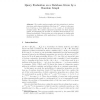1806 search results - page 14 / 362 » Randomness and halting probabilities |
ICDT
2007
ACM
14 years 1 months ago
2007
ACM
We consider random graphs, and their extensions to random structures, with edge probabilities of the form βn−α , where n is the number of vertices, α, β are fixed and α >...
JMLR
2012
11 years 10 months ago
2012
One approach to modeling structured discrete data is to describe the probability of states via an energy function and Gibbs distribution. A recurring difficulty in these models is...
CSR
2007
Springer
13 years 11 months ago
2007
Springer
We study the empirical meaning of randomness with respect to a family of probability distributions P, where is a real parameter, using algorithmic randomness theory. In the case w...
SODA
2004
ACM
13 years 8 months ago
2004
ACM
We consider the problem of finding a sparse set of edges containing the minimum spanning tree (MST) of a random subgraph of G with high probability. The two random models that we ...
CSDA
2007
13 years 7 months ago
2007
Random k-nearest-neighbour (RKNN) imputation is an established algorithm for filling in missing values in data sets. Assume that data are missing in a random way, so that missing...

